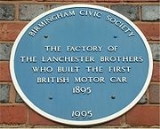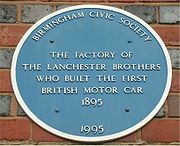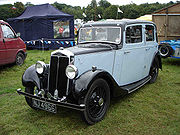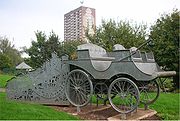
Lanchester Motor Company
Encyclopedia
The Lanchester Motor Company Limited was a car manufacturer based until 1930 at Armourer Mills, Montgomery Street, Sparkbrook, Birmingham
, England. It operated from 1895 to 1955.
The company was purchased by the BSA Group at the end of 1930 and its activities merged with those of Daimler
on Daimler's sites. Lanchester thus became part of Jaguar
in 1960. The rights to the Lanchester brand now belong to Tata Motors
of India, which purchased Jaguar from the Ford Motor Company
in March 2008 though it has been dormant since the last Lanchester rolled of the line in 1955. The Lanchester Motor Company Limited is still registered as an active company and accounts are filed each year though it is currently marked "non-trading".
 This business was started by the three Lanchester brothers, Frederick
This business was started by the three Lanchester brothers, Frederick
, one of the most influential automobile engineers of the 19th and 20th century, George
and Frank as the Lanchester Engine Company Ltd and registered in 1899.
Work on the first Lanchester car had been started in 1895, significantly designed from first principles as a car, not a horseless carriage, and it ran on the public roads in February or March 1896. It had a single cylinder 1306 cc engine with the piston having two connecting rods to separate crankshafts and flywheels rotating in opposite directions giving very smooth running. A two-cylinder engine was fitted to the same chassis in 1897 and a second complete car was built alongside it. This led on to the first production cars in 1900, when six were made as demonstrators. These had two-cylinder, 4033 cc, horizontal air-cooled engines, retaining the twin crankshaft design. Steering was by side lever not wheel. The gearbox used epicyclic gearing
. The first cars were sold to the public in 1901. In 1902 Lanchester became the first company to market disc brakes to the public. They were mechanical and on the front wheels only. The discs were very thin and made of a very soft metal like brass. Although probably leaving much to be desired, they completely fit the definition of a disc brake, and beat all others to market by many years.
 The 1904 models had 2470 cc, four-cylinder, water-cooled, overhead-valve engines featuring pressure lubrication, very unusual at the time, and were now mounted with the epicyclic gearbox between the front seats rather than centrally resulting a design with the driver sitting well forwards and no bonnet. Six-cylinder models joined the line up in 1906. The specification started to become more conventional with wheel steering as an option from 1908, becoming standard from the end of 1911, and pedals and gear lever replacing the original two-lever system of gear changing. George Lanchester was now in charge, Frederick having resigned in 1913, and the engine moved further forward to a conventional position in the sporting, side-valve, 5.5-litre six-cylinder Forty but very few were made before the outbreak of World War I. A distinctive feature of the engine's valves was their use of leaf springs, rather than coil springs. Frank Lanchester ran the London sales office.
The 1904 models had 2470 cc, four-cylinder, water-cooled, overhead-valve engines featuring pressure lubrication, very unusual at the time, and were now mounted with the epicyclic gearbox between the front seats rather than centrally resulting a design with the driver sitting well forwards and no bonnet. Six-cylinder models joined the line up in 1906. The specification started to become more conventional with wheel steering as an option from 1908, becoming standard from the end of 1911, and pedals and gear lever replacing the original two-lever system of gear changing. George Lanchester was now in charge, Frederick having resigned in 1913, and the engine moved further forward to a conventional position in the sporting, side-valve, 5.5-litre six-cylinder Forty but very few were made before the outbreak of World War I. A distinctive feature of the engine's valves was their use of leaf springs, rather than coil springs. Frank Lanchester ran the London sales office.
s built on the Lanchester 38 hp chassis for use by the Royal Naval Air Service
on the Western Front
.
For 1928 there was George's last design, a 4446 cc straight-8 but only 126 were made before the economic depression effectively killed demand.
The engines were 3,330 and 4,440 cc respectively, their wheelbase and track:
's Armourer Mills at Sparkbrook a sale to BSA made sense. Thomas Hamilton Barnsley (1867–1930), the principal shareholder, chairman and managing director negotiated a sale of the whole share capital to BSA group shortly before his death on Christmas Day 1930. BSA's purchase of the whole of the shares was completed in January 1931 for £26,000, a fraction of the value of the assets. Car production was transferred to Lanchester's new sister subsidiary, Daimler
, at Motor Mills, Sandy Lane, Radford.
 George Lanchester was kept on as a senior designer and Frank became the Lanchester sales director. The great years for Lanchester were now over and the models were generally overlooked by the company in favour of Daimler models. The first new offering, still designed by George Lanchester, was the Eighteen with hydraulic brakes and a Daimler fluid flywheel. The Ten of 1933 was an upmarket version of the BSA 10. The pre-war Fourteen of 1937, known also as the Roadrider, was almost identical to the longer Daimler DB17
George Lanchester was kept on as a senior designer and Frank became the Lanchester sales director. The great years for Lanchester were now over and the models were generally overlooked by the company in favour of Daimler models. The first new offering, still designed by George Lanchester, was the Eighteen with hydraulic brakes and a Daimler fluid flywheel. The Ten of 1933 was an upmarket version of the BSA 10. The pre-war Fourteen of 1937, known also as the Roadrider, was almost identical to the longer Daimler DB17
with its 1.6-litre six which anachronistically had a fixed cylinder head until 1938.
The then Duke of York
, a repeat customer during the 1930s, preferred this less showy version of Daimler cars and took delivery of a pair of specially built Daimler straight-eight limousines with the Lanchester grille and badges.
Post war, a ten-horsepower car was reintroduced with the 1287 cc LD10 which didn't have a Daimler equivalent and the four-cylinder 1950 Fourteen / Leda was upstaged in 1953 by a six-cylinder Daimler version called the Conquest.
The last model, of which only prototypes were produced, was called the Sprite and in 1956 the Lanchester name was phased out.
, who used the Daimler name in the same way Daimler had used the Lanchester name. Both became victims of badge engineering in their last years of production.
brand names.
in 2008, along with the Rover and Daimler
brand names, as part of a deal reached with the Ford Motor Company
to acquire their Jaguar Land Rover (JLR) business, as announced on 26 March 2008.
 An open-air sculpture, the Lanchester Car Monument
An open-air sculpture, the Lanchester Car Monument
, in the Bloomsbury, Heartlands, area of Birmingham, designed by Tim Tolkien
, is on the site where Lanchester built their first four-wheel petrol car in 1895.
Birmingham
Birmingham is a city and metropolitan borough in the West Midlands of England. It is the most populous British city outside the capital London, with a population of 1,036,900 , and lies at the heart of the West Midlands conurbation, the second most populous urban area in the United Kingdom with a...
, England. It operated from 1895 to 1955.
The company was purchased by the BSA Group at the end of 1930 and its activities merged with those of Daimler
Daimler Motor Company
The Daimler Motor Company Limited was an independent British motor vehicle manufacturer founded in London by H J Lawson in 1896, which set up its manufacturing base in Coventry. The right to the use of the name Daimler had been purchased simultaneously from Gottlieb Daimler and Daimler Motoren...
on Daimler's sites. Lanchester thus became part of Jaguar
Jaguar (car)
Jaguar Cars Ltd, known simply as Jaguar , is a British luxury car manufacturer, headquartered in Whitley, Coventry, England. It is part of the Jaguar Land Rover business, a subsidiary of the Indian company Tata Motors....
in 1960. The rights to the Lanchester brand now belong to Tata Motors
Tata Motors
Tata Motors Limited is an Indian multinational automotive corporation headquartered in Mumbai, India. Part of the Tata Group, it was formerly known as TELCO...
of India, which purchased Jaguar from the Ford Motor Company
Ford Motor Company
Ford Motor Company is an American multinational automaker based in Dearborn, Michigan, a suburb of Detroit. The automaker was founded by Henry Ford and incorporated on June 16, 1903. In addition to the Ford and Lincoln brands, Ford also owns a small stake in Mazda in Japan and Aston Martin in the UK...
in March 2008 though it has been dormant since the last Lanchester rolled of the line in 1955. The Lanchester Motor Company Limited is still registered as an active company and accounts are filed each year though it is currently marked "non-trading".
History

Frederick Lanchester
Frederick William Lanchester, Hon FRAeS was an English polymath and engineer who made important contributions to automotive engineering, aerodynamics and co-invented the field of operations research....
, one of the most influential automobile engineers of the 19th and 20th century, George
George Lanchester
George Herbert Lanchester, was an English engineer. He was one of three brothers who played a leading role in the early development of the UK auto-industry....
and Frank as the Lanchester Engine Company Ltd and registered in 1899.
Work on the first Lanchester car had been started in 1895, significantly designed from first principles as a car, not a horseless carriage, and it ran on the public roads in February or March 1896. It had a single cylinder 1306 cc engine with the piston having two connecting rods to separate crankshafts and flywheels rotating in opposite directions giving very smooth running. A two-cylinder engine was fitted to the same chassis in 1897 and a second complete car was built alongside it. This led on to the first production cars in 1900, when six were made as demonstrators. These had two-cylinder, 4033 cc, horizontal air-cooled engines, retaining the twin crankshaft design. Steering was by side lever not wheel. The gearbox used epicyclic gearing
Epicyclic gearing
Epicyclic gearing or planetary gearing is a gear system consisting of one or more outer gears, or planet gears, revolving about a central, or sun gear. Typically, the planet gears are mounted on a movable arm or carrier which itself may rotate relative to the sun gear...
. The first cars were sold to the public in 1901. In 1902 Lanchester became the first company to market disc brakes to the public. They were mechanical and on the front wheels only. The discs were very thin and made of a very soft metal like brass. Although probably leaving much to be desired, they completely fit the definition of a disc brake, and beat all others to market by many years.
The Crystal Palace Automobile Show, January 1903
All bodies were made by external coachbuilders until 1903 when a body department was set up and up to 1914 most cars carried Lanchester built bodies. In 1904, despite a full order book, the company ran out of money and receivers were called in. The company was re-organised and registered as The Lanchester Motor Company Limited later that year.
War
During the war the company made artillery shells and some aircraft engines but some vehicle production continued with the Lanchester 4x2 Armoured CarLanchester 4x2 Armoured Car
The Lanchester Armoured Car was a British armoured car produced during the First World War. It is not to be confused with an interwar period six-wheeled design.-History:...
s built on the Lanchester 38 hp chassis for use by the Royal Naval Air Service
Royal Naval Air Service
The Royal Naval Air Service or RNAS was the air arm of the Royal Navy until near the end of the First World War, when it merged with the British Army's Royal Flying Corps to form a new service , the Royal Air Force...
on the Western Front
Western Front (World War I)
Following the outbreak of World War I in 1914, the German Army opened the Western Front by first invading Luxembourg and Belgium, then gaining military control of important industrial regions in France. The tide of the advance was dramatically turned with the Battle of the Marne...
.
Postwar
After the first World war the company adopted a single model policy and the Forty was re-introduced with a 6.2-litre overhead-cam engine in unit with a 3-speed gearbox still using epicyclic gears and a worm drive rear axle. It was very expensive, dearer than a Rolls-Royce Silver Ghost and to maintain production a smaller car, the Twenty One joined the range in 1924. This had a 3.1-litre, six-cylinder engine, now with removable cylinder head, mated to a four-speed conventional gearbox and four-wheel brakes. It grew to the 3.3-litre Twenty Three in 1926. The Forty was finally replaced by the Thirty with straight-eight 4.4-litre engine in 1928. A further series of armoured cars were made in 1927 with six-wheel version of the Forty chassis.For 1928 there was George's last design, a 4446 cc straight-8 but only 126 were made before the economic depression effectively killed demand.
Olympia 1930
Twelve months after the Wall Street Crash these were the cars shown by Lanchester on their stand at the Olympia Motor Show in October 1930:- 21 hp 6-cylinder landaulette by Maythorn, £1,775, chassis only £1,050
- 31 hp 8-cylinder limousine by Hooper, £2,300, chassis only £1,325
- 31 hp 8-cylinder 6/7-seater coupé de ville by Windovers £2,435
The engines were 3,330 and 4,440 cc respectively, their wheelbase and track:
- 6-cylinder: 11ft 1in and 4ft 8in
- 8-cylinder: 11ft 10½ in and 4ft 8in
Sale or liquidation
Within weeks their bank called in the company's overdraft of £38,000 forcing immediate liquidation of the company's assets. Because their current premises once had been a part of BSABirmingham Small Arms Company
This article is not about Gamo subsidiary BSA Guns Limited of Armoury Road, Small Heath, Birmingham B11 2PP or BSA Company or its successors....
's Armourer Mills at Sparkbrook a sale to BSA made sense. Thomas Hamilton Barnsley (1867–1930), the principal shareholder, chairman and managing director negotiated a sale of the whole share capital to BSA group shortly before his death on Christmas Day 1930. BSA's purchase of the whole of the shares was completed in January 1931 for £26,000, a fraction of the value of the assets. Car production was transferred to Lanchester's new sister subsidiary, Daimler
Daimler Motor Company
The Daimler Motor Company Limited was an independent British motor vehicle manufacturer founded in London by H J Lawson in 1896, which set up its manufacturing base in Coventry. The right to the use of the name Daimler had been purchased simultaneously from Gottlieb Daimler and Daimler Motoren...
, at Motor Mills, Sandy Lane, Radford.
Daimler

Daimler New Fifteen
The Daimler New Fifteen, also called the DB17 was a large saloon/sedan car at the lower end of the manufacturer’s range, introduced towards the end of 1937 and offered for sale by Daimler in 1938 and 1939...
with its 1.6-litre six which anachronistically had a fixed cylinder head until 1938.
The then Duke of York
George VI of the United Kingdom
George VI was King of the United Kingdom and the Dominions of the British Commonwealth from 11 December 1936 until his death...
, a repeat customer during the 1930s, preferred this less showy version of Daimler cars and took delivery of a pair of specially built Daimler straight-eight limousines with the Lanchester grille and badges.
Post war, a ten-horsepower car was reintroduced with the 1287 cc LD10 which didn't have a Daimler equivalent and the four-cylinder 1950 Fourteen / Leda was upstaged in 1953 by a six-cylinder Daimler version called the Conquest.
The last model, of which only prototypes were produced, was called the Sprite and in 1956 the Lanchester name was phased out.
Jaguar
The parent company, Daimler, was in decline and in 1960 was absorbed by JaguarJaguar (car)
Jaguar Cars Ltd, known simply as Jaguar , is a British luxury car manufacturer, headquartered in Whitley, Coventry, England. It is part of the Jaguar Land Rover business, a subsidiary of the Indian company Tata Motors....
, who used the Daimler name in the same way Daimler had used the Lanchester name. Both became victims of badge engineering in their last years of production.
Ford
Ford's acquisition of Jaguar Cars in 1989 included the rights to the Lanchester and DaimlerDaimler Motor Company
The Daimler Motor Company Limited was an independent British motor vehicle manufacturer founded in London by H J Lawson in 1896, which set up its manufacturing base in Coventry. The right to the use of the name Daimler had been purchased simultaneously from Gottlieb Daimler and Daimler Motoren...
brand names.
Tata Motors
The rights to the Lanchester brand name passed to Tata MotorsTata Motors
Tata Motors Limited is an Indian multinational automotive corporation headquartered in Mumbai, India. Part of the Tata Group, it was formerly known as TELCO...
in 2008, along with the Rover and Daimler
Daimler Motor Company
The Daimler Motor Company Limited was an independent British motor vehicle manufacturer founded in London by H J Lawson in 1896, which set up its manufacturing base in Coventry. The right to the use of the name Daimler had been purchased simultaneously from Gottlieb Daimler and Daimler Motoren...
brand names, as part of a deal reached with the Ford Motor Company
Ford Motor Company
Ford Motor Company is an American multinational automaker based in Dearborn, Michigan, a suburb of Detroit. The automaker was founded by Henry Ford and incorporated on June 16, 1903. In addition to the Ford and Lincoln brands, Ford also owns a small stake in Mazda in Japan and Aston Martin in the UK...
to acquire their Jaguar Land Rover (JLR) business, as announced on 26 March 2008.
Monument

Lanchester Car Monument
The Lanchester Car Monument is an open-air galvanized steel sculpture of the Stanhope Phaeton, or Lanchester motor car. It is in Bloomsbury Village Green, a piece of reclaimed land in the Heartlands area of Birmingham, England...
, in the Bloomsbury, Heartlands, area of Birmingham, designed by Tim Tolkien
Tim Tolkien
Tim Tolkien is an English sculptor who has designed several monumental sculptures, including the award-winning Sentinel.His other claim to fame is as the great-nephew of J. R. R. Tolkien, the famous author of the fantasy book The Lord of the Rings...
, is on the site where Lanchester built their first four-wheel petrol car in 1895.
Lanchester cars
| Type | Engine | Approx Production | Year | Notes |
|---|---|---|---|---|
| Lanchester Five | 1306 cc single-cylinder air-cooled | 1 | 1895 | |
| Lanchester Eight | 3459 cc twin-cylinder air-cooled | 1 | 1897–1898 | |
| Lanchester Ten Lanchester 10 The Lanchester 10 is a car produced by the Lanchester Motor Company from 1900 until 1951. It was the first production car offered for sale by the company.-Lanchester 10 :... |
4033 cc twin-cylinder air-cooled | 1900–1904 | First production model | |
| Lanchester Twelve | 4033 cc twin-cylinder water-cooled | 1903–1904 | ||
| Lanchester Sixteen | 4838 cc twin-cylinder air-cooled | 20 | 1903–1904 | |
| Lanchester Eighteen | 4838 cc twin-cylinder water-cooled | 6 | 1904 | |
| Lanchester Twenty | 2472 cc overhead-valve four-cylinder water-cooled | 1904–1911 | ||
| Lanchester Twelve | 3974 cc twin-cylinder overhead-valve water-cooled | 1906–1908 | ||
| Lanchester 28 | 3654 cc six-cylinder overhead-valve water-cooled | 1906–1911 | ||
| Lanchester 50 | 8145 cc six-cylinder overhead-valve water-cooled | 1907 | ||
| Lanchester 38 | 4856 cc six-cylinder overhead-valve water-cooled | 1911–1914 | ||
| Lanchester 25 | 3137 cc four-cylinder overhead-valve water-cooled | 1912–1914 | ||
| Lanchester 40 | 5482 cc six-cylinder side-valve water-cooled | 1907 | ||
| Lanchester 40 | 6178 cc six-cylinder overhead-cam water-cooled | 392 | 1919–1928 | Chassis £2200. Four-wheel brakes from 1924 |
| Lanchester 21 | 2930 cc six-cylinder overhead-cam water-cooled | 735 (including Twenty Three) | 1923–1926 | Chassis £1000. |
| Lanchester 23 | 2930 cc six-cylinder overhead-cam water-cooled | 735 (including Twenty One) | 1926–1931 | Vacuum servo. |
| Lanchester 30 hp | 4400 cc eight-cylinder overhead-cam water-cooled | 126 | 1929–1932 | Chassis £1325 |
| Lanchester Eighteen | 2504 cc (2390 cc from 1935, 2565 cc from 1936) six-cylinder overhead-valve water-cooled | 2650 approx | 1932–1940 | Badge engineered Daimler Light 20. Fluid flywheel. |
| Lanchester Ten Lanchester 10 The Lanchester 10 is a car produced by the Lanchester Motor Company from 1900 until 1951. It was the first production car offered for sale by the company.-Lanchester 10 :... |
1203 cc (1444 cc from 1936) four-cylinder overhead-valve water-cooled | 12250 approx | 1933–1936 | Fluid flywheel. Hydraulic brakes until 1935. |
| Lanchester Light Six | 1378 cc six-cylinder overhead-valve water-cooled | 1075 approx | 1935–1936 | Saloon, Sports Saloon, Drophead Coupe. Similar to BSA. |
| Lanchester Eleven | 1444 cc four-cylinder overhead-valve water-cooled | 2000 approx | 1937–1940 | Saloon, Sports Saloon. |
| Lanchester Fourteen Roadrider | 1527 cc (1809 cc from 1938) six-cylinder overhead-valve water-cooled | 2000 approx | 1937–1940 | Saloon, Sports saloon. bendix brakes |
| Lanchester LD10 Lanchester 10 The Lanchester 10 is a car produced by the Lanchester Motor Company from 1900 until 1951. It was the first production car offered for sale by the company.-Lanchester 10 :... |
1287 cc four-cylinder overhead-valve water-cooled | 3030 | 1946–1951 | Independent front suspension, Mechanical brakes |
| Lanchester Fourteen/Leda | 1968 cc four-cylinder overhead-valve water-cooled | 2100 | 1950–1954 | Appropriated for badge engineered 1953 Daimler Conquest. Saloon and drophead coupe. |
| Lanchester Sprite | 1622 cc four-cylinder overhead-valve water-cooled | 10 | 1954–1956 | Hobbs automatic gearbox. Did not reach production. |

